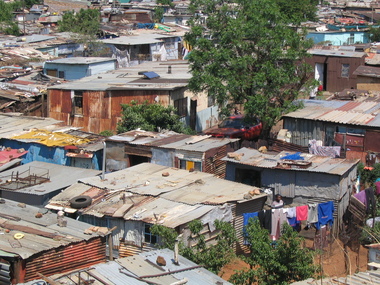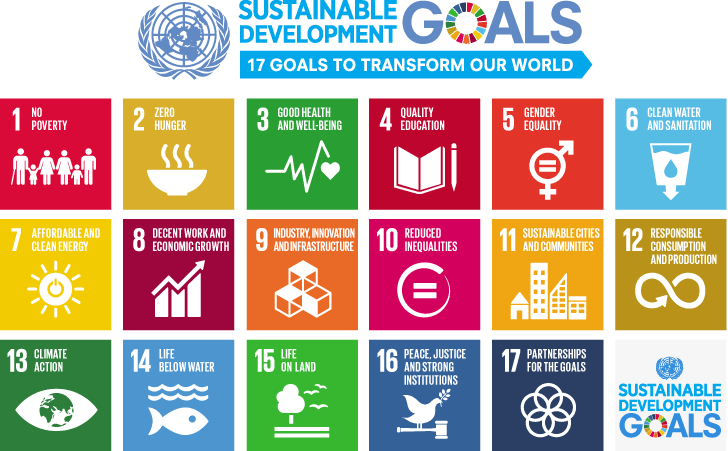22 Social and Economic Development
Learning Outcomes
- Define economic development through human development and standard of living principles
- Analyze access to social development constructs with a focus on healthcare and education
- Explain gender inequality, what is causing it, and what the world is trying to do to address it
- Explain global extreme poverty and what is being done about it
- Explain how international trade is helping some nations improve their economic and social status
Defining Human Development
HUMAN DEVELOPMENT INDEX
In order to analyze the world based on various levels of development, the term development must be defined. Development is the process of improving the material conditions of people through diffusion of knowledge and technology. All nations lie somewhere in the range of more developed countries (MDC) to less developed countries (LDC).
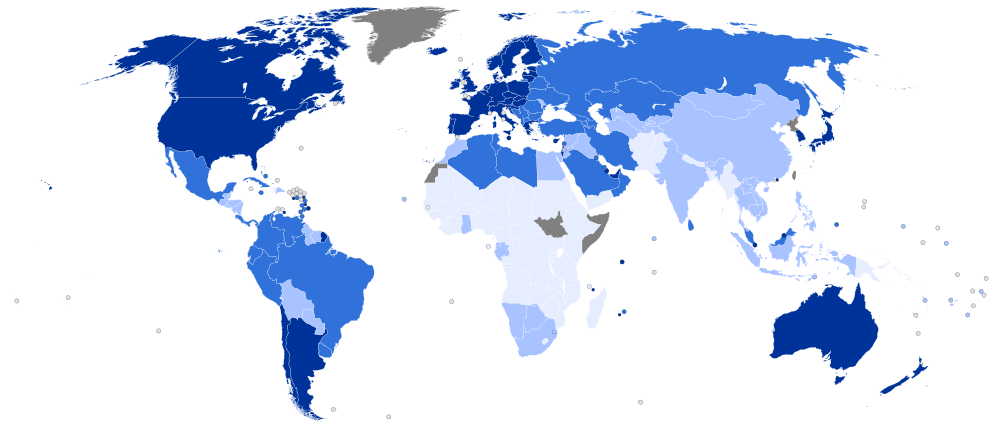
A nation’s development level is based on the United Nation’s Human Development Index (HDI), which focuses on economic, social, and demographic development. More specifically, the HDI focuses on a nation’s gross domestic product (GDP) for economics, literacy rates and education for social factors, and life expectancy for demographics. A country’s gross domestic product is the total market value of all officially recognized final goods and services produced within a country in a year. GDP per capita is often considered an indicator of a country’s standard of living.
STANDARD OF LIVING
Standard of living refers to the level of wealth, happiness, comfort, and material goods, necessities available to a certain socioeconomic class in a certain geographic area. The standard of living includes factors such as income, quality and availability of employment, class disparity, poverty rate, quality and affordability of housing, hours of work required to purchase necessities, GDP, inflation rates, affordability to quality heath care, quality and availability of education, life expectancy, incidence of disease, cost of goods and services, infrastructure, national economic growth, economic and political stability, political and religious freedom, environmental quality, to name a few. It’s interesting to note that the United States is not the highest on the HDI. The U.S. actually ranks 3rd because it is lower in education standards and life expectancy than most developed nations!
Jobs can be classified into three major types of sectors, which greatly influence the economics, standards of living, trade, and even social classes within a society. The first is called the primary sector, which are jobs directly related to the extraction of the Earth’s natural resources (e.g. forestry, raw materials, or agriculture). In the secondary sector, jobs are focused on manufacturing raw materials from the primary sector to usable products. The tertiary sector provides goods and services to people in exchange for payment. These types of jobs include lawyers, doctors, educators, banking, retail, athletes, and others.
It’s probably apparent that the majority of the jobs in developed countries (MDCs) are tertiary. There are primary and secondary sector jobs in countries like the United States, but the driving economic force is in the tertiary sector. MDCs are also more productive than LDCs, not because they work harder, but because of access and use of technology. In economics, productivity is the value of a particular product compared to the amount of labor needed to make it. Value added is the gross value of the product minus the cost of raw materials and energy.
Access to Social and Economic Development
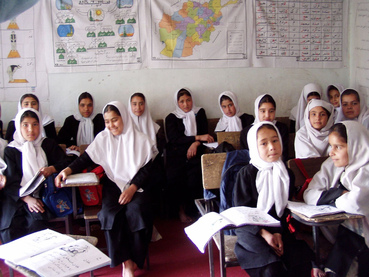
ACCESS TO QUALITY EDUCATION
MDCs have the ability to invest more money and resources because of their economies, thus their people tend to be more educated, healthier, children are more likely to survive, and adults tend to live longer than those in LDCs. Probably the two most important or basic components to have a nation’s developmental status to begin to rise is through education and heath care. There is a direct correlation to development and education. The more developed a nation, the more educated the population. In fact, one of the best indicators of a nation’s level of development is it’s literacy rate, the percent of people who can read or write. In MDCs, the literacy rate is usually around 98 percent, whereas in LDCs the literacy rate is around 60 percent. It impact of this is that books are written for people in MDCs and scientific advances tend to occur in these countries. Compared to LDCs, MDCs spend less of their GDP on education because their GDP’s are so high. A small amount of a developed nation’s GDP can have a higher monetary value than large amounts coming from the GDP of a less developed nation. In terms of percentage, LDCs spend more of their GDP on education than MDCs need to. In LDCs, the children going to school often have outdated books and not written in their primary language. Often times in LDCs, more schools are private than public because the government lacks the ability to fund them. Many of these schools are funded by outside religious groups and nonprofit organizations.
ACCESS TO HEALTH CARE
People are often healthier in MDCs than LDCs because of diet and healthcare. With diet, people in MDCs tend to have more access to calories, nutrients, and protein. But there is a dark side to this as well. Many developed countries are now experiencing epic obesity issues. In fact, more people in the world are obese than are hungry. It’s not just about consuming too much food; many nutrition experts would also question the quality of the protein and nutrients from this food that more and more is in the form of trans fats.
With access to healthcare, MDCs tend to spend more infesting in public health than possible in LDCs. This is done at the governmental, private business, and individual level. In MDCs, there is a much lower ratio of nurses or doctors to patients than in LDCs. Because of this investment in health, the life expectancy in MDCs is much higher. Men tend to live 10 years longer than those compared to LDCs; women can expect to live 13 years longer in MDCs than in LDCs. There is a gender issue related to this too. In MDCs, men tend to live 10 years longer than women LDCs. But higher life expectancy comes with a price too. People tend to work longer into their life, preventing advancement of younger generations. The longer life expectancy through retirement also means that social programs must support an aging population.
Children also tend to have a higher survival rate, called infant mortality rates, in MDCs than in LDCs. In MDCs, the survival rate of children is near 99 percent, whereas in LDCs the rate is around 94 percent. Children tend to have higher mortality rates in LDCs because of malnutrition, starvation, dehydration, disease, and lack of access to health services and professionals.
Gender Inequality
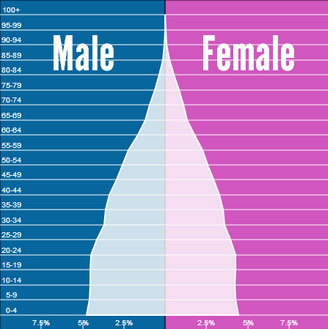
Do you think there are more men or women on the planet? Well if you look at the population pyramid on the left, you’ll see that women just outweigh men in population size. But what if the “data” doesn’t really meet the realities on the ground? It is believed that between 60-100 million females were born in the current population, but have now disappeared of the planet, a concept called gendercide.
Currently no social scientist or governmental agency like the United Nations has found a country where women are treated equal to men. To determine the equality, or inequality, of women in nations, the Gender Inequality Index (GII) is used. The index uses a variety of measures to determine the inequality of females compared to males including: labor, reproductive health, and empowerment. The higher the number that a region receives demonstrates the greater the inequality in that region.
Some nations have severe gender inequalities, meaning that women have nearly no legal, social, or economic rights even when they are head of their household. Many argue that if the world focused on gender equality of females, most of our social, economic, and environmental problems would be greatly minimized.
In the 21st Century, gender inequity as Sheryl WuDunn states in her TED Talk “Our Century’s Greatest Injustice? : is the moral and ethical issue of our time. Why have so many females disappeared out of the human population?
That’s the point of the organization Half the Sky. The title is a Chinese proverb that means women hold up half the sky, so women need to be part of the solution.
In terms of reproductive health, maternal mortality ratio and adolescent fertility rates are determined. The maternal mortality ratio is a measure of the number of women who die giving birth per 100,000 births. The adolescent fertility rate is a measurement of the number of births per 1,000 women between the ages of 15 through 19. In LDCs, women are more likely to die during labor and have children during their adolescent years. Reproductive health is an important indicator of gender inequality because women tend to have fewer rights, including access to health care, where the gender-related development index is high.
There are several organizations around the world that are working on empowering females from young to old through a range of social and economic policies. The ultimate goal of these organizations like Half the Sky, CARE, and The Girl Effect to name a few, is to empower women so that they might have legal, economic, social, and health rights. Empowerment is something that can be tracked and monitored because it’s a focus on two critical indicators in relation to gender inequality. One is to measure the percentage of seats held by women in a nation’s federal government. This is a basically a measurement of political and economic power women have or don’t have in a country.
Just take for example the United States Congress in 2013. Currently there are 20 women and 80 men serving in the Senate; there are 78 women and 357 men serving in the House of Representatives. How do you think that might influence policies to women, about women, and for women in the United States? How about the fact that no woman has ever served as President or Vice President and only one has served as the Speaker of the House, which is the third most powerful position in our federal government. The other is a measurement of the percent of women who have completed high school.
Ending Global Poverty
It can be said that issues such as literacy rates, life expectancy, natural increase, and infant mortality rates have improved in LDC. But the gap between development and income is only getting wider. Only one-fifth of the world’s population lives in MDC, but those same nations consume five-sixths of the world’s resources. In fact, if all 7 billion people on the planet lived the lifestyle of the average American, it would require three planets! Currently there are over 1 billion people on the planet living in what’s called extreme poverty.
James Rubenstein wrote in Cultural Landscape: An Introduction to Human Geography (2010), “The United Nations recently placed the contrast in spending between MDCs and LDCs in picturesque terms: Americans spend more per year on cosmetics ($8 billion) than the cost of providing schools for the 2 billion in the world in need of them ($6 billion), and Europeans spend more on ice cream ($11 billion) than the cost of providing a working toilet to the 2 billion people currently without one at home ($9 billion).” To put U.S. consumer spending in context with the cost of providing basic needs for those in the developing world, Americans spent $20 billion in 2007 on Black Friday–the day after Thanksgiving and the biggest shopping day of the year in the United States. Consider how redirecting the funds used for one day of shopping in the U.S. could do much to eradicate extreme poverty.
Currently over $1 billion people live in extreme poverty, a term used to define people who live on less than $1.25 a day for food, water, and shelter. In order for LDCs to develop, they first need to dramatically improve their gross national product (GNP). Once income starts flowing, that money needs to be invested into other HDI factors such social and other economic factors. The goal of the self-sufficiency model is to focus on reducing poverty than increasing wealth and creating wealth classes. Investment in a state’s infrastructure and economic structure is spread equally so that all benefit. The idea of “local first” outweighs globalization. The problem with this model is that it can quickly become inefficient because local industries are protected by the government from outside forces. Also, it requires a large governmental fingerprint to administer the controls and conditions to equally distribute the wealth.
International Development
SELF-EFFICIENCY MODEL OF DEVELOPMENT
There are two models of economic development that play off each other as a way to. The first model is called the Self-Efficiency Model of Development, which encourages domestic development of goods and resources and discourages foreign influence and investment. Between 1990 to 2000, this was the main form of economic development until globalization became the dominate force. What makes this model of development competitive to international trade models is that governments create barriers through the form of tariffs on imports, which makes them more expensive and less economically competitive with their local businesses. New businesses are nurtured until they and economically sustainable and competitive enough to compete with businesses abroad.This model of development prides itself in more equal distribution of resources to a nation’s people and businesses over foreign entities and investments. But there are several critics of this form of development because they argue that this model protects inefficient businesses and does not reward competitive and highly efficient ones, requires a large bureaucratic government to administer this model of development and limit abuse and corruption, and does not receive the benefits of rewarding foreign corporations that could provide goods and services to countries with limited resources.
MODERNIZATION MODEL OF DEVELOPMENT
The other model for economic development is through international trade. W.W. Rostow proposed in the 1950s the idea of five-stage model of development that competes with the self-sufficiency model. In a report by Peter Kasanda, Rostow’s Modernization Theory of Development implies that nations should use local resources and industries to sell scarce or needed resources globally through international trade. The money that comes back to the country would increase the nation’s GDP, which could then be used to improve the development of infrastructure, invest in education and healthcare, and ultimately improve a country’s standard of living. The following is the 5-stage model of how progress and development might occur for a country:
- Traditional Society – This primary sector is determined for societies that have little economic development and a high percentage of people active in family-scale subsistence agriculture. Most of the money for development goes toward religious or military activities.
- Economic Growth – Key investments in core structures of the existing economy to expand it’s development. Structured invests in mining and larger-scale agriculture and with technology to enhance the efficiency of existing infrastructure. The goal is to invest in the overall structure of the nation’s economy so the production of goods can begin to occur.
- Economic Takeoff – Investment and development leads to expanded, but limited activity in mining, textile, and food production along with continued improvements and investment in modern technology. A key indicator of the “takeoff” stage is when the people in the country become more driven by economic development rather than traditional activities. Is should also be noted that this is often times when concerning issues of slavery and sweatshops begin to surface if not handled properly.
- Drive to Economic Maturity – During this period, society is driven by modern technological advances over most other areas of the economy. Technology drives production and efficiency throughout all parts of the economy. It is at this time when a local economy becomes an international economic player. This stage is often times said to be an extension of the “takeoff” stage, but more expansive than limited in scope.
- Age of Mass Consumption – This final stage of economic development occurs when an economy shifts from a secondary sector of manufacturing toward the tertiary sector of services. The economic status of the nation’s society also becomes driven by mass consumption of disposable goods.
The theory of international trade has become the preferred way to improve economic development. The reason is because most nations cannot produce all the goods and resources they require. So if nations can focus on specific goods and services to export, they can return purchase the goods and services they need.
In 1995, the World Trade Organization (WTO) was created to represent 97 percent of the world-trading establishment. It is through the WTO that nations can negotiate with each other international trade restrictions, governmental subsidies and tariffs on exports. The WTO also has the power to act like an international court to enforce international agreements.
The WTO has been highly attacked by liberals and conservatives. Liberals believe that too many actions or rulings are done undemocratically and behind close doors. They also believe the organization focuses more on the rights of corporations rather than poorer nations. Conservatives believe that no international organization has the right to dictate the choices of sovereign nations. Learn more about the World Trade Organization.
ECONOMIC SLAVERY
There’s also a darker side to international trade and that exists in the black market. On the poaching side, animals ranging from mountain gorillas, rhinoceroses, and African elephants are being slaughtered for parts to be sold. There are also natural resources such as diamonds, gold, stonery, textiles, and more that are either mined or assembled using mass slavery. The products are sold to MDCs to fund local and regional civil wars like the in Uganda, Angola, Sierra Leon, and the Democratic Republic of Congo. Many times, people of all age groups who try to escape slavery are often times raped, have body parts amputated alive and with no medicine, or killed all to fear, power, and control. The TED Talk “Photos that Bear Witness to Modern Slavery” and National Geographic Society’s documentary “Diamonds of War: Africa’s Blood Diamonds” are both powerful, but disturbing witnesses of how slavery is used all around the world to fund political conflicts and wars.
UNITED NATIONS MILLENNIUM DEVELOPMENT GOALS
There is broad global support for addressing extreme poverty because of it’s implications in regards to global and local economics, environmental protection, geopolitical stability of governments, and humanitarian efforts. In 2002, the United Nations created the Millennium Development Goals (MDGs) to proactively reduce extreme poverty in half by 2015. The MDGs are broken down into eight smaller goals, each with a specific target or mission to accomplish.
The MDGs have been updated and are now called the Sustainable Development Goals. These are overarching guidelines that all major policies and programs run in cooperation with the UN strive to achieve.
In Bono’s TED Talk on global poverty, he said “Human beings have been campaigning against inequality and poverty for 3,000 years, but this journey is accelerating. Bono ’embraces his inner nerd’ and shares inspiring data that shows the end of poverty is in sight … if we can harness the momentum. Bono, the lead singer of U2, uses his celebrity to fight for social justice worldwide: to end hunger, poverty and disease, especially in Africa. His nonprofit ONE raises awareness via media, policy and calls to action.” Some may ask, why Bono? He’s just a millionaire “rock star” who doesn’t know a thing about poverty issues. It turns out that Bono is extremely active in humanitarian issues and one of the largest philanthropists in the world. He started the ONE Campaign to help inform, educate, and advocate about extreme poverty. He has also studied under one of the economic leaders on global poverty, Dr. Jeffrey Sachs, the Director of the Earth Institute at Columbia University and one of the original leaders of the MDGs.

